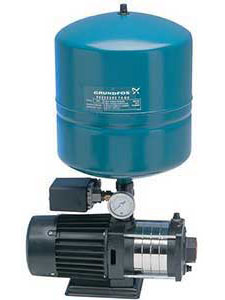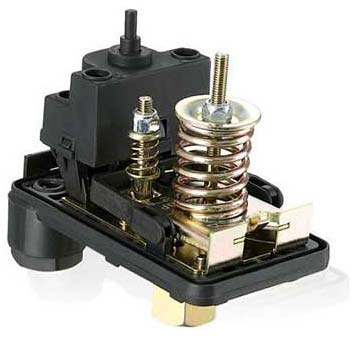Water Pump Problems
Solving water pump problems
Many of us depend on water pumps, but how reliable are they, what can go wrong with them and how do we repair them?
Here we look at water pumps, noisy pumps, worn bearings, burned out motors, capacitors, pumps switching on and off, low water pressure, pressure tanks and how to stop the pump "cycling".
We also provide a troubleshooting guide.
See also:
- Water pressure problems
- Types of water pumps
- Water pump size
- Water pump switching on and off
- Water pump pressure tanks
Water pumps are generally very reliable

Water pumps are little heroes in our homes but are usually forgotten until we have a problem. As long as you buy a good quality pump they are generally very reliable working without attention often for years on end. They are inexpensive but an essential component in the systems that make our lives comfortable, would you want to go back to a well and a bucket when flushing the toilet or having a shower?
Parts of a water pump
A basic water pump consists of an impellor, a wheel with vanes on it, mounted in a housing with an inlet pipe and an outlet pipe - a simple but effective arrangement. the pump is attached to an electric motor which drives it.
There are several components attached to water pumps to improve their performance and their usefulness:
Capacitor
A capacitor is a clever little bleeder. It collects electrical energy then, when it has enough, it releases it in a zap of extra energy. Very useful as ice breakers at parties, capacitors are used to give a burst of extra energy to get things going. On electric motors they give an extra burst of energy to get them turning. Normally cylindrical about 2 cms diameter and 8 cms long with a wire coming out of one end the capacitor is usually mounted inside a small cover on the outside of the electric motor.
Pressure switches
Many of the water pumps we use have pressure switches which sense the pressure of the water in the pump's outlet pipe and switch the pump on and off. You will find the pressure switches mounted on a small pipe screwed into the pump housing with a plastic cap covering the electrics.

Normally the water in your water system is pressurised. If you turn on a tap the pressure in your water system is released which in turn releases the pressure on the pressure switch which then operates to turn your water pump on.
The pump will run until the water in the outlet pipe increases to a pre set maximum pressure, when this pressure is reached the pressure in the water operates the switch to turn the pump off.
We do not want the same pressure to switch the pump on and off and so in fact there are two pressure switches each set at a predetermined pressure. In most systems we might set the switches to switch the pump on if the water pressure falls to say 24 psi (pounds per square inch) then the pump will run until the pressure reaches say 40 psi. These pressures vary according to your individual needs and how your water system is designed.
Pressure tank
If we have a large water pump trying to pump water out of a small tap the pump will switch on and start pumping water but, because the water cannot get out of the tap quickly enough the pressure may build up and the pump will switch itself off again; but then the water running out of the tap catches up, the pressure in the water falls so the pump starts again. This process is repeated continually and the pump is cycling on and off (I am sure many of you will be familiar with the comforting sound of the stuttering water pump). The pump switching on and off rapidly is not good for the pump, for the switches or for the electricity bill to say nothing of the modern day "water torture" that keeps you awake at night. For more information on cycling water pumps see the article at www.mrfixitbali.com/articles/water-pump-cycling-165.html
To solve this problem we attach a pressure tank to the pump and most of the water pumps we use have pressure tanks attached to them. Pressure tanks are steel tanks filled with air which is contained inside a rubber bladder. Water is not compressible but air is and so, if we pump water into the tank, this will progressively squeeze the air contained in the bladder to a smaller and smaller volume effectively storing up the pressure. Now if we turn a tap on the pressure in the water is released and the air will gradually expand pushing the water out of the tap.
When the pressure tank has ejected all its water it is now filled with air at low pressure, the water pump will start and will run until the air is fully compressed and, with the system back up to pressure again the pump will stop. This means that the water pump will still start and stop but at a much slower rate than if the pressure tank is not there.
Pressure tanks, in fact, perform two functions, while their main function is storing pressure as we have explained they also provide an air cushion in the water system which absorbs shocks in the system when taps are suddenly turned on or off.
Water Pump Troubleshooting Guide
Water pumps are very reliable however things can, and do, go wrong from time to time.
| Problem | Possible cause | Action |
|---|---|---|
| Pump will not start | Problems with power supply. | Check the plug and socket and the cable. Check circuit breaker in electrical panel. |
| Capacitor not working. | Needs a new capacitor, not expensive. | |
| Air pressure in water pressure tank too high. | Reset air pressure in pressure tank. | |
| Problems with water storage tank level sensor. | Check water tank level sensor. | |
| Pump motor burned out. | Rewind or replace the pump. | |
| Motor bearings worn out. | Replace bearings or replace pump. | |
| Pump will not stop. | Leaks in the pipes. | Find and repair leaks. |
| Problems with the level sensor or ball valve in a water storage tank. | Check level sensor or ball valve in storage tank. | |
| Air in pump inlet pipe. | Check inlet pipe for leaks. | |
| Water supply empty. | Check bore, well or water tank to see if there is water. | |
| Pump switching on and off when all taps are turned off | Leaks in the water system. | Find and repair leaks. |
| Problems with water storage tank ball valve or level sensor. | Check level sensor or ball valve in storage tank. | |
| Pump switching on and off too quickly. | Pressure switches incorrectly set | Reset pressure switch operating pressures. |
| Insufficient air in water pressure tank. | Pump up pressure tank (note having the correct pressure is important). | |
| Bladder burst in pressure tank. | Replace bladder. | |
| Water pipes too small a diameter. | Install larger diameter pipes. | |
| Pump is noisy and/or vibrating. | Bearings worn out. | Replace bearing or replace pump. |
- Water pressure problems
- Types of water pumps
- Water pump size
- Water pump switching on and off
- Water pump pressure tanks
Phil Wilson
Copyright © Phil Wilson August 2015
This article, or any part of it, cannot be copied or reproduced without permission from the copyright owner.
